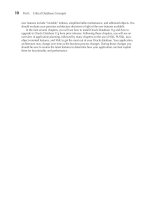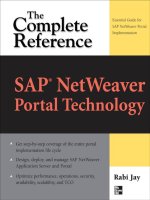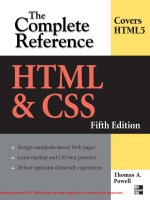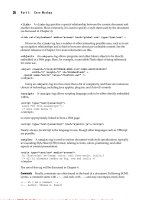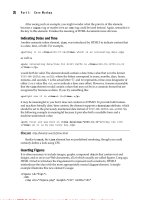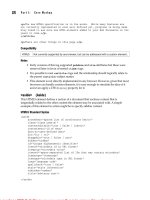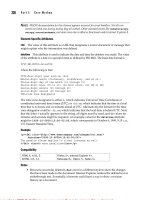Springer data compression the complete reference (springer 4th ed 2007)
Bạn đang xem bản rút gọn của tài liệu. Xem và tải ngay bản đầy đủ của tài liệu tại đây (8.84 MB, 1,111 trang )
Data Compression
Fourth Edition
David Salomon
With Contributions by Giovanni Motta and David Bryant
Data Compression
The Complete Reference
Fourth Edition
Professor David Salomon (emeritus)
Computer Science Department
California State University
Northridge, CA 91330-8281
USA
Email:
British Library Cataloguing in Publication Data
A catalogue record for this book is available from the British Library
Library of Congress Control Number: 2006931789
ISBN-10: 1-84628-602-6
ISBN-13: 978-1-84628-602-5
e-ISBN-10: 1-84628-603-4
e-ISBN-13: 978-1-84628-603-2
Printed on acid-free paper.
© Springer-Verlag London Limited 2007
Apart from any fair dealing for the purposes of research or private study, or criticism or review, as permitted under
the Copyright, Designs and Patents Act 1988, this publication may only be reproduced, stored or transmitted, in
any form or by any means, with the prior permission in writing of the publishers, or in the case of reprographic
reproduction in accordance with the terms of licences issued by the Copyright Licensing Agency. Enquiries
concerning reproduction outside those terms should be sent to the publishers.
The use of registered names, trademarks, etc. in this publication does not imply, even in the absence of a specific
statement, that such names are exempt from the relevant laws and regulations and therefore free for general use.
The publisher makes no representation, express or implied, with regard to the accuracy of the information
contained in this book and cannot accept any legal responsibility or liability for any errors or omissions that may
be made.
9 8 7 6 5 4 3 2 1
Springer Science+Business Media, LLC
springer.com
To Wayne Wheeler, an editor par excellence
Write your own story. Don’t let others write it for you.
Chinese fortune-cookie advice
Preface to the
Fourth Edition
I was pleasantly surprised when in November 2005 a message arrived from Wayne
Wheeler, the new computer science editor of Springer Verlag, notifying me that he intends to qualify this book as a Springer major reference work (MRW), thereby releasing
past restrictions on page counts, freeing me from the constraint of having to compress
my style, and making it possible to include important and interesting data compression
methods that were either ignored or mentioned in passing in previous editions.
These fascicles will represent my best attempt to write a comprehensive account, but
computer science has grown to the point where I cannot hope to be an authority on
all the material covered in these books. Therefore I’ll need feedback from readers in
order to prepare the official volumes later.
I try to learn certain areas of computer science exhaustively; then I try to digest that
knowledge into a form that is accessible to people who don’t have time for such study.
—Donald E. Knuth, (2006)
Naturally, all the errors discovered by me and by readers in the third edition have
been corrected. Many thanks to all those who bothered to send error corrections, questions, and comments. I also went over the entire book and made numerous additions,
corrections, and improvements. In addition, the following new topics have been included
in this edition:
Tunstall codes (Section 2.4). The advantage of variable-size codes is well known to
readers of this book, but these codes also have a downside; they are difficult to work
with. The encoder has to accumulate and append several such codes in a short buffer,
wait until n bytes of the buffer are full of code bits (where n must be at least 1), write the
n bytes on the output, shift the buffer n bytes, and keep track of the location of the last
bit placed in the buffer. The decoder has to go through the reverse process. The idea
of Tunstall codes is to construct a set of fixed-size codes, each encoding a variable-size
string of input symbols. As an aside, the “pod” code (Table 7.29) is also a new addition.
viii
Preface to the Fourth Edition
Recursive range reduction (3R) (Section 1.7) is a simple coding algorithm due to
Yann Guidon that offers decent compression, is easy to program, and its performance is
independent of the amount of data to be compressed.
LZARI, by Haruhiko Okumura (Section 3.4.1), is an improvement of LZSS.
RAR (Section 3.20). The popular RAR software is the creation of Eugene Roshal.
RAR has two compression modes, general and special. The general mode employs an
LZSS-based algorithm similar to ZIP Deflate. The size of the sliding dictionary in RAR
can be varied from 64 Kb to 4 Mb (with a 4 Mb default value) and the minimum match
length is 2. Literals, offsets, and match lengths are compressed further by a Huffman
coder. An important feature of RAR is an error-control code that increases the reliability
of RAR archives while being transmitted or stored.
7-z and LZMA (Section 3.24). LZMA is the main (as well as the default) algorithm
used in the popular 7z (or 7-Zip) compression software [7z 06]. Both 7z and LZMA are
the creations of Igor Pavlov. The software runs on Windows and is free. Both LZMA
and 7z were designed to provide high compression, fast decompression, and low memory
requirements for decompression.
Stephan Wolf made a contribution to Section 4.30.4.
H.264 (Section 6.8). H.264 is an advanced video codec developed by the ISO and
the ITU as a replacement for the existing video compression standards H.261, H.262,
and H.263. H.264 has the main components of its predecessors, but they have been
extended and improved. The only new component in H.264 is a (wavelet based) filter,
developed specifically to reduce artifacts caused by the fact that individual macroblocks
are compressed separately.
Section 7.4 is devoted to the WAVE audio format. WAVE (or simply Wave) is the
native file format employed by the Windows opearting system for storing digital audio
data.
FLAC (Section 7.10). FLAC (free lossless audio compression) is the brainchild of
Josh Coalson who developed it in 1999 based on ideas from Shorten. FLAC was especially designed for audio compression, and it also supports streaming and archival
of audio data. Coalson started the FLAC project on the well-known sourceforge Web
site [sourceforge.flac 06] by releasing his reference implementation. Since then many
developers have contributed to improving the reference implementation and writing alternative implementations. The FLAC project, administered and coordinated by Josh
Coalson, maintains the software and provides a reference codec and input plugins for
several popular audio players.
WavPack (Section 7.11, written by David Bryant). WavPack [WavPack 06] is a
completely open, multiplatform audio compression algorithm and software that supports
three compression modes, lossless, high-quality lossy, and a unique hybrid compression
mode. It handles integer audio samples up to 32 bits wide and also 32-bit IEEE floatingpoint data [IEEE754 85]. The input stream is partitioned by WavPack into blocks that
can be either mono or stereo and are generally 0.5 seconds long (but the length is actually
flexible). Blocks may be combined in sequence by the encoder to handle multichannel
audio streams. All audio sampling rates are supported by WavPack in all its modes.
Preface to the Fourth Edition
ix
Monkey’s audio (Section 7.12). Monkey’s audio is a fast, efficient, free, lossless
audio compression algorithm and implementation that offers error detection, tagging,
and external support.
MPEG-4 ALS (Section 7.13). MPEG-4 Audio Lossless Coding (ALS) is the latest
addition to the family of MPEG-4 audio codecs. ALS can input floating-point audio
samples and is based on a combination of linear prediction (both short-term and longterm), multichannel coding, and efficient encoding of audio residues by means of Rice
codes and block codes (the latter are also known as block Gilbert-Moore codes, or
BGMC [Gilbert and Moore 59] and [Reznik 04]). Because of this organization, ALS is
not restricted to the encoding of audio signals and can efficiently and losslessly compress
other types of fixed-size, correlated signals, such as medical (ECG and EEG) and seismic
data.
AAC (Section 7.15). AAC (advanced audio coding) is an extension of the three
layers of MPEG-1 and MPEG-2, which is why it is often called mp4. It started as part of
the MPEG-2 project and was later augmented and extended as part of MPEG-4. Apple
Computer has adopted AAC in 2003 for use in its well-known iPod, which is why many
believe (wrongly) that the acronym AAC stands for apple audio coder.
Dolby AC-3 (Section 7.16). AC-3, also known as Dolby Digital, stands for Dolby’s
third-generation audio coder. AC-3 is a perceptual audio codec based on the same
principles as the three MPEG-1/2 layers and AAC. The new section included in this
edition concentrates on the special features of AC-3 and what distinguishes it from other
perceptual codecs.
Portable Document Format (PDF, Section 8.13). PDF is a popular standard for
creating, editing, and printing documents that are independent of any computing platform. Such a document may include text and images (graphics and photos), and its
components are compressed by well-known compression algorithms.
Section 8.14 (written by Giovanni Motta) covers a little-known but important aspect
of data compression, namely how to compress the differences between two files.
Hyperspectral data compression (Section 8.15, partly written by Giovanni Motta)
is a relatively new and growing field. Hyperspectral data is a set of data items (called
pixels) arranged in rows and columns where each pixel is a vector. A home digital camera
focuses visible light on a sensor to create an image. In contrast, a camera mounted on
a spy satellite (or a satellite searching for minerals and other resources) collects and
measures radiation of many wavelegths. The intensity of each wavelength is converted
into a number, and the numbers collected from one point on the ground form a vector
that becomes a pixel of the hyperspectral data.
Another pleasant change is the great help I received from Giovanni Motta, David
Bryant, and Cosmin Trut¸a. Each proposed topics for this edition, went over some of
the new material, and came up with constructive criticism. In addition, David wrote
Section 7.11 and Giovanni wrote Section 8.14 and part of Section 8.15.
I would like to thank the following individuals for information about certain topics
and for clearing up certain points. Igor Pavlov for help with 7z and LZMA, Stephan
Wolf for his contribution, Matt Ashland for help with Monkey’s audio, Yann Guidon
x
Preface to the Fourth Edition
for his help with recursive range reduction (3R), Josh Coalson for help with FLAC, and
Eugene Roshal for help with RAR.
In the first volume of this biography I expressed my gratitude to those individuals
and corporate bodies without whose aid or encouragement it would not have been
undertaken at all; and to those others whose help in one way or another advanced its
progress. With the completion of this volume my obligations are further extended. I
should like to express or repeat my thanks to the following for the help that they have
given and the premissions they have granted.
Christabel Lady Aberconway; Lord Annan; Dr Igor Anrep; . . .
—Quentin Bell, Virginia Woolf: A Biography (1972)
Currently, the book’s Web site is part of the author’s Web site, which is located
at Domain DavidSalomon.name has been reserved and will always point to any future location of the Web site. The author’s email
address is , but email sent to anyname @DavidSalomon.name will
be forwarded to the author.
Those interested in data compression in general should consult the short section
titled “Joining the Data Compression Community,” at the end of the book, as well as
the following resources:
/> /> and
o/.
(URLs are notoriously short lived, so search the Internet).
People err who think my art comes easily to me.
—Wolfgang Amadeus Mozart
Lakeside, California
David Salomon
Preface to the
Third Edition
I was pleasantly surprised when in December 2002 a message arrived from the editor
asking me to produce the third edition of the book and proposing a deadline of late April
2003. I was hoping for a third edition mainly because the field of data compression has
made great strides since the publication of the second edition, but also for the following
reasons:
Reason 1: The many favorable readers’ comments, of which the following are typical
examples:
First I want to thank you for writing “Data Compression: The Complete Reference.”
It is a wonderful book and I use it as a primary reference.
I wish to add something to the errata list of the 2nd edition, and, if I am allowed,
I would like to make a few comments and suggestions.. . .
—Cosmin Trut¸a, 2002
sir,
i am ismail from india. i am an computer science engineer. i did project in data
compression on that i open the text file. get the keyword (symbols,alphabets,numbers
once contained word). Then sorted the keyword by each characters occurrences in the
text file. Then store the keyword in a file. then following the keyword store the 000
indicator.Then the original text file is read. take the first character of the file.get the
positional value of the character in the keyword. then store the position in binary. if
that binary contains single digit, the triple bit 000 is assigned. the binary con two digit,
the triple bit 001 is assigned. so for 256 ascii need max of 8 digit binary.plus triple bit
.so max needed for the 256th char in keyword is 11 bits. but min need for the first char
in keyworkd is one bit+three bit , four bit. so writing continuously o’s and 1’s in a file.
and then took the 8 by 8 bits and convert to equal ascii character and store in the file.
thus storing keyword + indicator + converted ascii char
can give the compressed file.
xii
Preface to the Third Edition
then reverse the process we can get the original file.
These ideas are fully mine.
(See description in Section 3.2).
Reason 2: The errors found by me and by readers in the second edition. They are
listed in the second edition’s Web site, and they have been corrected in the third edition.
Reason 3: The title of the book (originally chosen by the publisher). This title had
to be justified by making the book a complete reference. As a result, new compression
methods and background material have been added to the book in this edition, while the
descriptions of some of the older, obsolete methods have been deleted or “compressed.”
The most important additions and changes are the following:
The BMP image file format is native to the Microsoft Windows operating system.
The new Section 1.4.4 describes the simple version of RLE used to compress these files.
Section 2.5 on the Golomb code has been completely rewritten to correct mistakes
in the original text. These codes are used in a new, adaptive image compression method
discussed in Section 4.22.
Section 2.9.6 has been added to briefly mention an improved algorithm for adaptive
Huffman compression.
The PPM lossless compression method of Section 2.18 produces impressive results,
but is not used much in practice because it is slow. Much effort has been spent exploring
ways to speed up PPM or make it more efficient. This edition presents three such efforts,
the PPM* method of Section 2.18.6, PPMZ (Section 2.18.7), and the fast PPM method
of Section 2.18.8. The first two try to explore the effect of unbounded-length contexts
and add various other improvements to the basic PPM algorithm. The third attempts
to speed up PPM by eliminating the use of escape symbols and introducing several
approximations. In addition, Section 2.18.4 has been extended and now contains some
information on two more variants of PPM, namely PPMP and PPMX.
The new Section 3.2 describes a simple, dictionary-based compression method.
LZX, an LZ77 variant for the compression of cabinet files, is the topic of Section 3.7.
Section 8.14.2 is a short introduction to the interesting concept of file differencing,
where a file is updated and the differences between the file before and after the update
are encoded.
The popular Deflate method is now discussed in much detail in Section 3.23.
The popular PNG graphics file format is described in the new Section 3.25.
Section 3.26 is a short description of XMill, a special-purpose compressor for XML
files.
Section 4.6 on the DCT has been completely rewritten. It now describes the DCT,
shows two ways to interpret it, shows how the required computations can be simplified,
lists four different discrete cosine transforms, and includes much background material.
As a result, Section 4.8.2 was considerably cut.
Preface to the Third Edition
xiii
An N -tree is an interesting data structure (an extension of quadtrees) whose compression is discussed in the new Section 4.30.4.
Section 5.19, on JPEG 2000, has been brought up to date.
MPEG-4 is an emerging international standard for audiovisual applications. It
specifies procedures, formats, and tools for authoring multimedia content, delivering
it, and consuming (playing and displaying) it. Thus, MPEG-4 is much more than a
compression method. Section 6.6 is s short description of the main features of and tools
included in MPEG-4.
The new lossless compression standard approved for DVD-A (audio) is called MLP.
It is the topic of Section 7.7. This MLP should not be confused with the MLP image
compression method of Section 4.21.
Shorten, a simple compression algorithm for waveform data in general and for speech
in particular, is a new addition (Section 7.9).
SCSU is a new compression algorithm, designed specifically for compressing text
files in Unicode. This is the topic of Section 8.12. The short Section 8.12.1 is devoted
to BOCU-1, a simpler algorithm for Unicode compression.
Several sections dealing with old algorithms have either been trimmed or completely
removed due to space considerations. Most of this material is available on the book’s
Web site.
All the appendixes have been removed because of space considerations. They are
freely available, in PDF format, at the book’s Web site. The appendixes are (1) the
ASCII code (including control characters); (2) space-filling curves; (3) data structures
(including hashing); (4) error-correcting codes; (5) finite-state automata (this topic is
needed for several compression methods, such as WFA, IFS, and dynamic Markov coding); (6) elements of probability; and (7) interpolating polynomials.
A large majority of the exercises have been deleted. The answers to the exercises
have also been removed and are available at the book’s Web site.
I would like to thank Cosmin Trut¸a for his interest, help, and encouragement.
Because of him, this edition is better than it otherwise would have been. Thanks also
go to Martin Cohn and Giovanni Motta for their excellent prereview of the book. Quite
a few other readers have also helped by pointing out errors and omissions in the second
edition.
Currently, the book’s Web site is part of the author’s Web site, which is located
at Domain BooksByDavidSalomon.com has
been reserved and will always point to any future location of the Web site. The author’s
email address is , but it’s been arranged that email sent to
anyname @BooksByDavidSalomon.com will be forwarded to the author.
Readers willing to put up with eight seconds of advertisement can be redirected
to the book’s Web site from Email sent to
will also be redirected.
Those interested in data compression in general should consult the short section
titled “Joining the Data Compression Community,” at the end of the book, as well as
the following resources:
xiv
Preface to the Third Edition
/> /> and
o/.
(URLs are notoriously short lived, so search the Internet).
One consequence of the decision to take this course is that I am, as I set down these
sentences, in the unusual position of writing my preface before the rest of my narrative.
We are all familiar with the after-the-fact tone—weary, self-justificatory, aggrieved,
apologetic—shared by ship captains appearing before boards of inquiry to explain how
they came to run their vessels aground, and by authors composing forewords.
—John Lanchester, The Debt to Pleasure (1996)
Northridge, California
David Salomon
Preface to the
Second Edition
This second edition has come about for three reasons. The first one is the many favorable
readers’ comments, of which the following is an example:
I just finished reading your book on data compression. Such joy.
And as it contains many algorithms in a volume only some 20 mm
thick, the book itself serves as a fine example of data compression!
—Fred Veldmeijer, 1998
The second reason is the errors found by the author and by readers in the first
edition. They are listed in the book’s Web site (see below), and they have been corrected
in the second edition.
The third reason is the title of the book (originally chosen by the publisher). This
title had to be justified by making the book a complete reference. As a result, many
compression methods and much background material have been added to the book in
this edition. The most important additions and changes are the following:
Three new chapters have been added. The first is Chapter 5, on the relatively
young (and relatively unknown) topic of wavelets and their applications to image and
audio compression. The chapter opens with an intuitive explanation of wavelets, using
the continuous wavelet transform (CWT). It continues with a detailed example that
shows how the Haar transform is used to compress images. This is followed by a general
discussion of filter banks and the discrete wavelet transform (DWT), and a listing of
the wavelet coefficients of many common wavelet filters. The chapter concludes with
a description of important compression methods that either use wavelets or are based
on wavelets. Included among them are the Laplacian pyramid, set partitioning in hierarchical trees (SPIHT), embedded coding using zerotrees (EZW), the WSQ method
for the compression of fingerprints, and JPEG 2000, a new, promising method for the
compression of still images (Section 5.19).
xvi
Preface to the Second Edition
The second new chapter, Chapter 6, discusses video compression. The chapter
opens with a general description of CRT operation and basic analog and digital video
concepts. It continues with a general discussion of video compression, and it concludes
with a description of MPEG-1 and H.261.
Audio compression is the topic of the third new chapter, Chapter 7. The first
topic in this chapter is the properties of the human audible system and how they can
be exploited to achieve lossy audio compression. A discussion of a few simple audio
compression methods follows, and the chapter concludes with a description of the three
audio layers of MPEG-1, including the very popular mp3 format.
Other new material consists of the following:
Conditional image RLE (Section 1.4.2).
Scalar quantization (Section 1.6).
The QM coder used in JPEG, JPEG 2000, and JBIG is now included in Section 2.16.
Context-tree weighting is discussed in Section 2.19. Its extension to lossless image
compression is the topic of Section 4.24.
Section 3.4 discusses a sliding buffer method called repetition times.
The troublesome issue of patents is now also included (Section 3.25).
The relatively unknown Gray codes are discussed in Section 4.2.1, in connection
with image compression.
Section 4.3 discusses intuitive methods for image compression, such as subsampling
and vector quantization.
The important concept of image transforms is discussed in Section 4.4. The discrete
cosine transform (DCT) is described in detail. The Karhunen-Lo`eve transform, the
Walsh-Hadamard transform, and the Haar transform are introduced. Section 4.4.5 is a
short digression, discussing the discrete sine transform, a poor, unknown cousin of the
DCT.
JPEG-LS, a new international standard for lossless and near-lossless image compression, is the topic of the new Section 4.7.
JBIG2, another new international standard, this time for the compression of bi-level
images, is now found in Section 4.10.
Section 4.11 discusses EIDAC, a method for compressing simple images. Its main
innovation is the use of two-part contexts. The intra context of a pixel P consists of
several of its near neighbors in its bitplane. The inter context of P is made up of pixels
that tend to be correlated with P even though they are located in different bitplanes.
There is a new Section 4.12 on vector quantization followed by sections on adaptive
vector quantization and on block truncation coding (BTC).
Block matching is an adaptation of LZ77 (sliding window) for image compression.
It can be found in Section 4.14.
Preface to the Second Edition
xvii
Differential pulse code modulation (DPCM) is now included in the new Section 4.23.
An interesting method for the compression of discrete-tone images is block decomposition (Section 4.25).
Section 4.26 discusses binary tree predictive coding (BTPC).
Prefix image compression is related to quadtrees. It is the topic of Section 4.27.
Another image compression method related to quadtrees is quadrisection. It is
discussed, together with its relatives bisection and octasection, in Section 4.28.
The section on WFA (Section 4.31) was wrong in the first edition and has been
completely rewritten with much help from Karel Culik and Raghavendra Udupa.
Cell encoding is included in Section 4.33.
DjVu is an unusual method, intended for the compression of scanned documents.
It was developed at Bell Labs (Lucent Technologies) and is described in Section 5.17.
The new JPEG 2000 standard for still image compression is discussed in the new
Section 5.19.
Section 8.4 is a description of the sort-based context similarity method. This method
uses the context of a symbol in a way reminiscent of ACB. It also assigns ranks to
symbols, and this feature relates it to the Burrows-Wheeler method and also to symbol
ranking.
Prefix compression of sparse strings has been added to Section 8.5.
FHM is an unconventional method for the compression of curves. It uses Fibonacci
numbers, Huffman coding, and Markov chains, and it is the topic of Section 8.9.
Sequitur, Section 8.10, is a method especially suited for the compression of semistructured text. It is based on context-free grammars.
Section 8.11 is a detailed description of edgebreaker, a highly original method for
compressing the connectivity information of a triangle mesh. This method and its various
extensions may become the standard for compressing polygonal surfaces, one of the
most common surface types used in computer graphics. Edgebreaker is an example of a
geometric compression method.
All the appendices have been deleted because of space considerations. They are
freely available, in PDF format, at the book’s Web site. The appendices are (1) the
ASCII code (including control characters); (2) space-filling curves; (3) data structures
(including hashing); (4) error-correcting codes; (5) finite-state automata (this topic is
needed for several compression methods, such as WFA, IFS, and dynamic Markov coding); (6) elements of probability; and (7) interpolating polynomials.
The answers to the exercises have also been deleted and are available at the book’s
Web site.
Currently, the book’s Web site is part of the author’s Web site, which is located
at Domain name BooksByDavidSalomon.com has
been reserved and will always point to any future location of the Web site. The author’s
xviii
Preface to the Second Edition
email address is , but it is planned that any email sent to
anyname @BooksByDavidSalomon.com will be forwarded to the author.
Readers willing to put up with eight seconds of advertisement can be redirected
to the book’s Web site from Email sent to
will also be redirected.
Those interested in data compression in general should consult the short section
titled “Joining the Data Compression Community,” at the end of the book, as well as
the two URLs and
/>Northridge, California
David Salomon
Preface to the
First Edition
Historically, data compression was not one of the first fields of computer science. It
seems that workers in the field needed the first 20 to 25 years to develop enough data
before they felt the need for compression. Today, when the computer field is about 50
years old, data compression is a large and active field, as well as big business. Perhaps
the best proof of this is the popularity of the Data Compression Conference (DCC, see
end of book).
Principles, techniques, and algorithms for compressing different types of data are
being developed at a fast pace by many people and are based on concepts borrowed from
disciplines as varied as statistics, finite-state automata, space-filling curves, and Fourier
and other transforms. This trend has naturally led to the publication of many books on
the topic, which poses the question, Why another book on data compression?
The obvious answer is, Because the field is big and getting bigger all the time,
thereby “creating” more potential readers and rendering existing texts obsolete in just
a few years.
The original reason for writing this book was to provide a clear presentation of
both the principles of data compression and all the important methods currently in
use, a presentation geared toward the nonspecialist. It is the author’s intention to have
descriptions and discussions that can be understood by anyone with some background
in the use and operation of computers. As a result, the use of mathematics is kept to a
minimum and the material is presented with many examples, diagrams, and exercises.
Instead of trying to be rigorous and prove every claim, the text many times says “it can
be shown that . . . ” or “it can be proved that . . . .”
The exercises are an especially important feature of the book. They complement the
material and should be worked out by anyone who is interested in a full understanding of
data compression and the methods described here. Almost all the answers are provided
(at the book’s Web page), but the reader should obviously try to work out each exercise
before peeking at the answer.
xx
Preface to the First Edition
Acknowledgments
I would like especially to thank Nelson Beebe, who went meticulously over the entire
text of the first edition and made numerous corrections and suggestions. Many thanks
also go to Christopher M. Brislawn, who reviewed Section 5.18 and gave us permission
to use Figure 5.64; to Karel Culik and Raghavendra Udupa, for their substantial help
with weighted finite automata (WFA); to Jeffrey Gilbert, who went over Section 4.28
(block decomposition); to John A. Robinson, who reviewed Section 4.29 (binary tree
predictive coding); to Øyvind Strømme, who reviewed Section 5.10; to Frans Willems
and Tjalling J. Tjalkins, who reviewed Section 2.19 (context-tree weighting); and to
Hidetoshi Yokoo, for his help with Sections 3.17 and 8.4.
The author would also like to thank Paul Amer, Guy Blelloch, Mark Doyle, Hans
Hagen, Emilio Millan, Haruhiko Okumura, and Vijayakumaran Saravanan, for their help
with errors.
We seem to have a natural fascination with shrinking and expanding objects. Since
our practical ability in this respect is very limited, we like to read stories where people
and objects dramatically change their natural size. Examples are Gulliver’s Travels by
Jonathan Swift (1726), Alice in Wonderland by Lewis Carroll (1865), and Fantastic
Voyage by Isaac Asimov (1966).
Fantastic Voyage started as a screenplay written by the famous writer Isaac Asimov.
While the movie was being produced (it was released in 1966), Asimov rewrote it as
a novel, correcting in the process some of the most glaring flaws in the screenplay.
The plot concerns a group of medical scientists placed in a submarine and shrunk to
microscopic dimensions. They are then injected into the body of a patient in an attempt
to remove a blood clot from his brain by means of a laser beam. The point is that the
patient, Dr. Benes, is the scientist who improved the miniaturization process and made
it practical in the first place.
Because of the success of both the movie and the book, Asimov later wrote Fantastic
Voyage II: Destination Brain, but the latter novel proved a flop.
But before we continue here is a question that you
might have already asked: “OK, but why should I
be interested in data compression?” Very simple:
“DATA COMPRESSION SAVES YOU MONEY!”
More interested now? We think you should be. Let
us give you an example of data compression application
that you see every day. Exchanging faxes every day . . .
From />
Northridge, California
David Salomon
Contents
Preface to the Fourth Edition
vii
Preface to the Third Edition
xi
Preface to the Second Edition
xv
Preface to the First Edition
xix
Introduction
1
2
Basic Techniques
1.1
Intuitive Compression
1.2
Run-Length Encoding
1.3
RLE Text Compression
1.4
RLE Image Compression
1.5
Move-to-Front Coding
1.6
Scalar Quantization
1.7
Recursive Range Reduction
Statistical Methods
2.1
Information Theory Concepts
2.2
Variable-Size Codes
2.3
Prefix Codes
2.4
Tunstall Code
2.5
The Golomb Code
2.6
The Kraft-MacMillan Inequality
2.7
Shannon-Fano Coding
2.8
Huffman Coding
2.9
Adaptive Huffman Coding
2.10
MNP5
2.11
MNP7
2.12
Reliability
2.13
Facsimile Compression
2.14
Arithmetic Coding
1
17
17
22
23
27
37
40
42
47
48
54
55
61
63
71
72
74
89
95
100
101
104
112
xxii
Contents
2.15
2.16
2.17
2.18
2.19
3
Adaptive Arithmetic Coding
The QM Coder
Text Compression
PPM
Context-Tree Weighting
125
129
139
139
161
Dictionary Methods
3.1
3.2
3.3
3.4
3.5
3.6
3.7
3.8
3.9
3.10
3.11
3.12
3.13
3.14
3.15
3.16
3.17
3.18
3.19
3.20
3.21
3.22
3.23
3.24
3.25
3.26
3.27
3.28
3.29
3.30
3.31
String Compression
Simple Dictionary Compression
LZ77 (Sliding Window)
LZSS
Repetition Times
QIC-122
LZX
LZ78
LZFG
LZRW1
LZRW4
LZW
LZMW
LZAP
LZY
LZP
Repetition Finder
UNIX Compression
GIF Images
RAR and WinRAR
The V.42bis Protocol
Various LZ Applications
Deflate: Zip and Gzip
LZMA and 7-Zip
PNG
XML Compression: XMill
EXE Compressors
CRC
Summary
Data Compression Patents
A Unification
171
173
174
176
179
182
184
187
189
192
195
198
199
209
212
213
214
221
224
225
226
228
229
230
241
246
251
253
254
256
256
259
Contents
4
xxiii
Image Compression
263
4.1
Introduction
265
4.2
Approaches to Image Compression
270
4.3
Intuitive Methods
283
4.4
Image Transforms
284
4.5
Orthogonal Transforms
289
4.6
The Discrete Cosine Transform
298
4.7
Test Images
333
4.8
JPEG
337
4.9
JPEG-LS
354
4.10
Progressive Image Compression
360
4.11
JBIG
369
4.12
JBIG2
378
4.13
Simple Images: EIDAC
389
4.14
Vector Quantization
390
4.15
Adaptive Vector Quantization
398
4.16
Block Matching
403
4.17
Block Truncation Coding
406
4.18
Context-Based Methods
412
4.19
FELICS
415
4.20
Progressive FELICS
417
4.21
MLP
422
4.22
Adaptive Golomb
436
4.23
PPPM
438
4.24
CALIC
439
4.25
Differential Lossless Compression
442
4.26
DPCM
444
4.27
Context-Tree Weighting
449
4.28
Block Decomposition
450
4.29
Binary Tree Predictive Coding
454
4.30
Quadtrees
461
4.31
Quadrisection
478
4.32
Space-Filling Curves
485
4.33
Hilbert Scan and VQ
487
4.34
Finite Automata Methods
497
4.35
Iterated Function Systems
513
4.36
Cell Encoding
529
xxiv
5
6
7
Contents
Wavelet Methods
5.1
Fourier Transform
5.2
The Frequency Domain
5.3
The Uncertainty Principle
5.4
Fourier Image Compression
5.5
The CWT and Its Inverse
5.6
The Haar Transform
5.7
Filter Banks
5.8
The DWT
5.9
Multiresolution Decomposition
5.10
Various Image Decompositions
5.11
The Lifting Scheme
5.12
The IWT
5.13
The Laplacian Pyramid
5.14
SPIHT
5.15
CREW
5.16
EZW
5.17
DjVu
5.18
WSQ, Fingerprint Compression
5.19
JPEG 2000
Video Compression
6.1
Analog Video
6.2
Composite and Components Video
6.3
Digital Video
6.4
Video Compression
6.5
MPEG
6.6
MPEG-4
6.7
H.261
6.8
H.264
Audio Compression
7.1
Sound
7.2
Digital Audio
7.3
The Human Auditory System
7.4
WAVE Audio Format
μ-Law and A-Law Companding
7.5
7.6
ADPCM Audio Compression
7.7
MLP Audio
7.8
Speech Compression
7.9
Shorten
7.10
FLAC
7.11
WavPack
7.12
Monkey’s Audio
7.13
MPEG-4 Audio Lossless Coding (ALS)
7.14
MPEG-1/2 Audio Layers
7.15
Advanced Audio Coding (AAC)
7.16
Dolby AC-3
531
532
534
538
540
543
549
566
576
589
589
596
608
610
614
626
626
630
633
639
653
653
658
660
664
676
698
703
706
719
720
724
727
734
737
742
744
750
757
762
772
783
784
795
821
847
Contents
8
xxv
Other Methods
851
8.1
The Burrows-Wheeler Method
8.2
Symbol Ranking
8.3
ACB
8.4
Sort-Based Context Similarity
8.5
Sparse Strings
8.6
Word-Based Text Compression
8.7
Textual Image Compression
8.8
Dynamic Markov Coding
8.9
FHM Curve Compression
8.10
Sequitur
8.11
Triangle Mesh Compression: Edgebreaker
8.12
SCSU: Unicode Compression
8.13
Portable Document Format (PDF)
8.14
File Differencing
8.15
Hyperspectral Data Compression
Answers to Exercises
853
858
862
868
874
885
888
895
903
906
911
922
928
930
941
953
Bibliography
1019
Glossary
1041
Joining the Data Compression Community
1067
Index
1069
Each memorable verse of a true poet has
two or three times the written content.
—Alfred de Musset
Introduction
Giambattista della Porta, a Renaissance scientist sometimes known as the professor of
secrets, was the author in 1558 of Magia Naturalis (Natural Magic), a book in which
he discusses many subjects, including demonology, magnetism, and the camera obscura
[della Porta 58]. The book became tremendously popular in the 16th century and went
into more than 50 editions, in several languages beside Latin. The book mentions an
imaginary device that has since become known as the “sympathetic telegraph.” This
device was to have consisted of two circular boxes, similar to compasses, each with a
magnetic needle. Each box was to be labeled with the 26 letters, instead of the usual
directions, and the main point was that the two needles were supposed to be magnetized
by the same lodestone. Porta assumed that this would somehow coordinate the needles
such that when a letter was dialed in one box, the needle in the other box would swing
to point to the same letter.
Needless to say, such a device does not work (this, after all, was about 300 years
before Samuel Morse), but in 1711 a worried wife wrote to the Spectator, a London periodical, asking for advice on how to bear the long absences of her beloved husband. The
adviser, Joseph Addison, offered some practical ideas, then mentioned Porta’s device,
adding that a pair of such boxes might enable her and her husband to communicate
with each other even when they “were guarded by spies and watches, or separated by
castles and adventures.” Mr. Addison then added that, in addition to the 26 letters,
the sympathetic telegraph dials should contain, when used by lovers, “several entire
words which always have a place in passionate epistles.” The message “I love you,” for
example, would, in such a case, require sending just three symbols instead of ten.
A woman seldom asks advice before
she has bought her wedding clothes.
—Joseph Addison
This advice is an early example of text compression achieved by using short codes
for common messages and longer codes for other messages. Even more importantly, this
shows how the concept of data compression comes naturally to people who are interested
in communications. We seem to be preprogrammed with the idea of sending as little
data as possible in order to save time.


